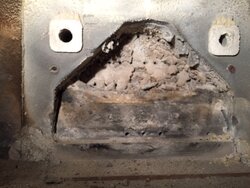I've had a Harman TL300 for about 10 years now. In general the stove is great. However a couple aspects of it drive me nuts.
1) The afterburner gets clogged up, falls apart, needs replacing every 3yrs or so, and is expensive ($450)
2) The fancy bricks surrounding the afterburner throat crack and are also expensive.
After recently having to pull _all_ the bricks out in order vacuum out the afterburner, and noticing it is about needing replaced, and most of the bricks are broken... I started shopping around for something to replace it with.
However I haven't found anything I like better. The huge/sealed ash bit with grate that the ashes just fall into is my main "must have". That I cannot find that feature on any other stove. If anyone knows of one, I'd like to know.
I'm an engineer, and as such I feel the desire to "design something better"... Does anyone have thoughts on building a steel afterburner to replace the fragile fiber-board POS? I realize it needs to maintain the heat to do do it's job - (I assume that is the reason for the fiber-board.) So a steel AB would need to be well insulated (on the outside).
I would like to design it such that any internal baffles could be easily removed from the front for ease of cleaning. And while I'm at it, replace the fancy custom bricks with some standard bricks... I wonder if the air chambers in those bricks really do much anyway?
Love to hear anyone's thoughts - would this be a waste of time, or worth a try?
1) The afterburner gets clogged up, falls apart, needs replacing every 3yrs or so, and is expensive ($450)
2) The fancy bricks surrounding the afterburner throat crack and are also expensive.
After recently having to pull _all_ the bricks out in order vacuum out the afterburner, and noticing it is about needing replaced, and most of the bricks are broken... I started shopping around for something to replace it with.
However I haven't found anything I like better. The huge/sealed ash bit with grate that the ashes just fall into is my main "must have". That I cannot find that feature on any other stove. If anyone knows of one, I'd like to know.
I'm an engineer, and as such I feel the desire to "design something better"... Does anyone have thoughts on building a steel afterburner to replace the fragile fiber-board POS? I realize it needs to maintain the heat to do do it's job - (I assume that is the reason for the fiber-board.) So a steel AB would need to be well insulated (on the outside).
I would like to design it such that any internal baffles could be easily removed from the front for ease of cleaning. And while I'm at it, replace the fancy custom bricks with some standard bricks... I wonder if the air chambers in those bricks really do much anyway?
Love to hear anyone's thoughts - would this be a waste of time, or worth a try?



 Always good to get a reality check.
Always good to get a reality check.